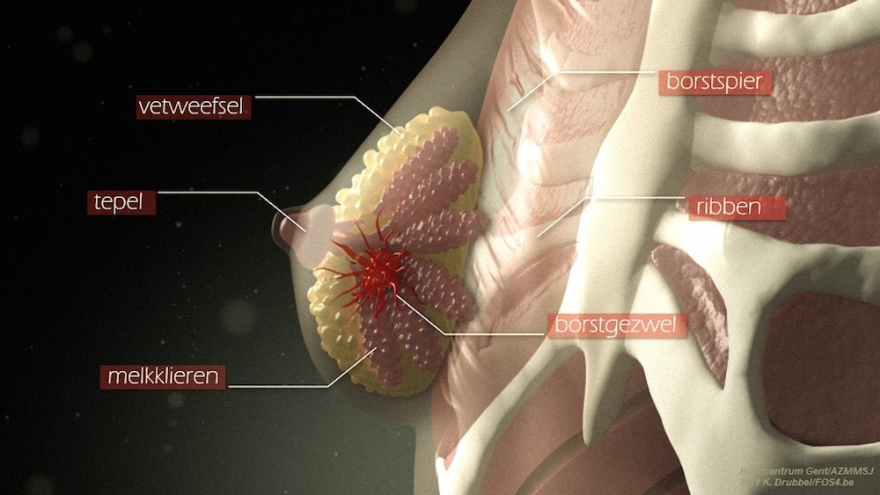Breast cancer
Symptoms and causes
Symptoms and causes
What is it?
Breast cancer is the development of a malignant degeneration in the breast gland tissue. Internally, the breast consists mainly of glandular, binding and fatty tissue. The glandular tissue contains about twenty mammary glands, each of which has a channel under the nipple and is separated by connective tissue partitions. In most cases, degeneration occurs in the milk ducts, less frequently in the glandular tissue itself. Rarer the tumours are on the nipple, in the skin, muscle cells under the nipple, connective tissue and blood and lymph vessels.
Diagnosis and treatment
Diagnosis and treatmentDiagnosis
In order to be able to notice a change in time yourself, it is a good idea to check your breasts regularly at any age. There are several starting points.
Suspicious lesion on mammography and ultrasound
Usually, a suspicious lesion is found during routine screening. Microcalcifications are often seen. This examination is best complemented by a puncture biopsy under ultrasound (when the lesion or calcifications can be observed under ultrasound) or by a stereotactic biopsy (see below).
Lump in the breast or skin retraction
If the lesion is suspect, clinically or radiologically, it is best to perform a puncture biopsy. This means that the physician will remove tissue cells using a thin needle. After microscopic examination of that tissue, it becomes clear whether or not the lesion is malignant.
Nipple loss
Besides the clinical examination and the mammography, the physician also examines the structure and cells of the nipple fluid and a galactography is performed. That is an examination of the nipple gland and milk ducts. Afterwards, the observed lesion is removed and examined microscopically. If it is malicious, a balance is drawn up for further discussion.
Skin lesions of the nipple
In case of a skin lesion of the nipple, a mammogram and preferably also a NMR examination will be performed. In addition, a piece of tissue (biopsy) of the lesion or nipple will be removed under local anaesthesia.
Swollen glands in the armpit
When one or more glands in the armpit are enlarged, even if a further examination and palpation of the breast is normal, it is best to perform a puncture of this gland with a fine needle. This will allow for the examination of tissue cells.
Inflammation of the breast
In case of redness and/or accumulation of fluid (oedema), you have to distinguish between an infection and an underlying (extensive) malignant process. NMR examination and tissue examination can help to make the correct diagnosis through a biopsy.
Further testing
Further testingMedical imaging
The aim of the imaging is to detect as many breast tumours as possible at an early stage, with as few side effects as possible on the physical and mental well-being of the patient. The three main imaging techniques are:
These three techniques work in completely different ways and therefore give a very different picture of the mammary gland and breast cancer.
Tissue examination
Tissue examination is essential to diagnose cancer. The pathologist is the specialist who determines whether there is cancer or not, by means of tissue analysis in the lab. For this, she needs a piece of representative tissue (biopsy) that can be obtained in different ways.
Staging examinations
Once the diagnosis of breast cancer has been confirmed, the attending physician will request additional 'staging examinations'. This means that the physician will determine what stage the cancer is in so that the spread of cancer cells (metastases) can potentially be ruled out.
Read more here about the different staging examinations.
Treatment
TreatmentNot every patient receive the same medical treatment. Everything depends on the type of cancer diagnosed, the degree of malignancy, the stage of the cancer, the scientific evidence of the efficacy of treatment for this type of cancer and the general state of health. Your physician will map out everything you need to choose the most appropriate treatment.
Surgery
Most patients need surgery to remove their tumour. Two surgeries are possible for breast cancer treatment: a breast-conserving operation or a complete removal of the breast. Sometimes, the lymph nodes in the armpit are also removed during the operation because the cancer often spreads through the lymph nodes. It is therefore important to check whether the lymph nodes also contain cancer cells. Here you can consult information about all possible breast cancer operations as well as the possibility of breast reconstruction.
Complementary therapies
Treatment centres and specialisations
Treatment centres and specialisations
Latest publication date: 23/01/2024
Supervising author: Dr Elzo Kraemer Ximena, Dr De Craene Annick









